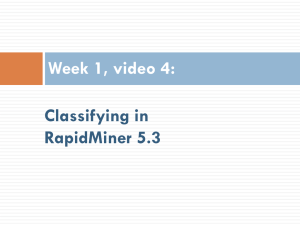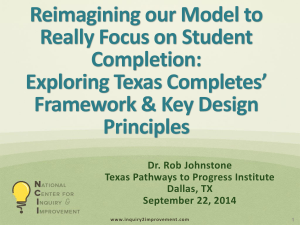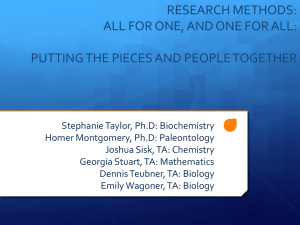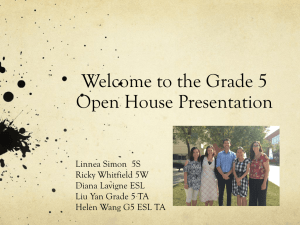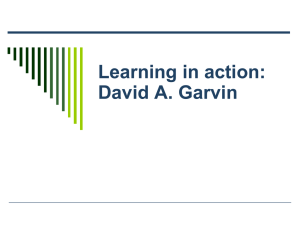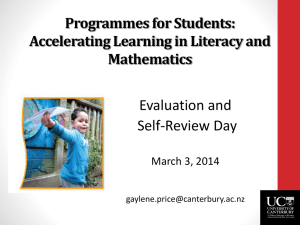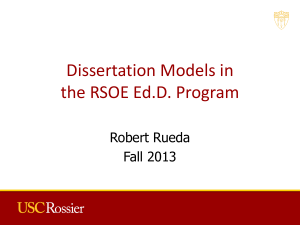How a Culture of Inquiry Can Help Your College Move the Needle
advertisement
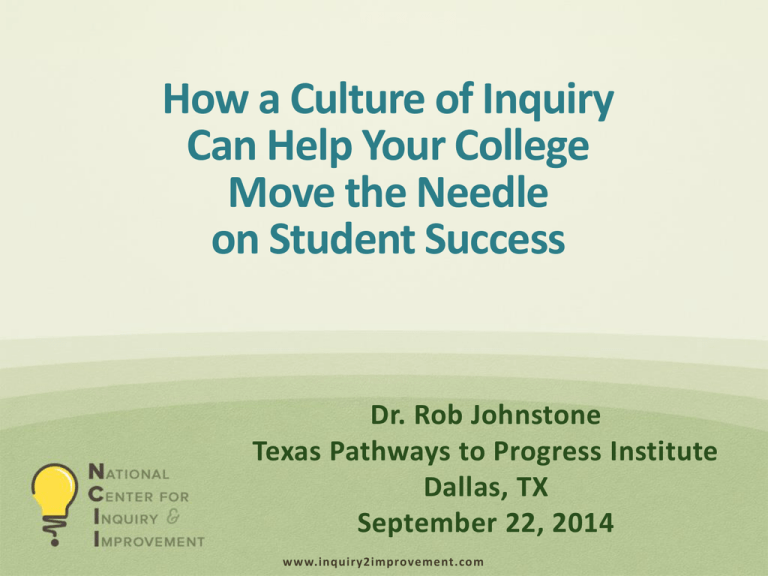
How a Culture of Inquiry Can Help Your College Move the Needle on Student Success Dr. Rob Johnstone Texas Pathways to Progress Institute Dallas, TX September 22, 2014 www.inquiry2improvement.com Acknowledgements Much of the content in this presentation in conjunction with national projects such as Completion by Design, the Aspen Prize for CC Excellence, and Bridging Research, Information & Cultures (BRIC) Content has also been developed by and with a host of national partners, including: • • • • • Community College Research Center (CCRC) Jobs for the Future JBL Associates Public Agenda The Research & Planning (RP) Group Infographics were primarily designed by Greg Stoup National Center for Inquiry & Improvement www.inquiry2improvement.com Formalistic Doublespeak… • Give your 1st reaction to the following list of words: • • • • • • • • • • • • Accountability Accreditation Assessment Continuous Improvement Data-Driven Decision Making Evaluation Institutional Effectiveness Key Performance Indicators (KPIs) Learning Outcomes Assessment Performance-based Funding Program Review Strategic planning National Center for Inquiry & Improvement www.inquiry2improvement.com Recapturing the Movement… • Vivid imagery from previous slide • Faculty, Student Services folks & leaders have been beaten over the head with these phrases they are correct to analyze that they too often haven’t led to authentic improvement and the more formal the process, often… •There is good news for our improvement efforts – you can do all of the things captured by those words in more authentic and less formalistic ways National Center for Inquiry & Improvement www.inquiry2improvement.com Changing the Conversations… • We have to make the conversation about things faculty, staff & administrators care about – students, their learning, and improving their outcomes and lives • Not everybody will come along – but we don’t need everybody • Org Change Thought: Red light / Yellow light / Green light • People need to see their expertise acknowledged and integrated – and the effect of their efforts on outcomes National Center for Inquiry & Improvement www.inquiry2improvement.com April 2014 A Culture of Inquiry & Action A RESOURCE for INSTITUTIONAL change www.inquiry2improvement.com 6 An Applied Inquiry Framework for Student Completion (CBD) Stage 1 – Explore how to improve outcomes Stage 2 – Gather meaningful evidence Stage 3 – Discuss evidence broadly Stage 4 – Use evidence to inform change Stage 5 – Measure the impact of change National Center for Inquiry & Improvement www.inquiry2improvement.com 7 What is a Culture of Inquiry? Institutional capacity for supporting open, honest and collaborative dialog focused on strengthening the institution and the outcomes of its students. National Center for Inquiry & Improvement www.inquiry2improvement.com 8 Culture of Inquiry: Features ● Widespread access to user-friendly information on student outcomes ● Encouraging more people to ask a wider collection of questions and use their evidence and conclusions to enhance decision making ● Reflective and dynamic discussions across constituency groups National Center for Inquiry & Improvement www.inquiry2improvement.com 9 Culture of Inquiry: More Features ● Continuous feedback so adjustments can be made along the way and processes can be adapted ● A sense of ownership over improving student outcomes – not blaming the student ● Using insight generated from inquiry to act at varying levels of the institution to create the conditions to improve outcomes National Center for Inquiry & Improvement www.inquiry2improvement.com 10 S TA G E 1 Explore how to improve student outcomes Focus inquiry on designing approaches that improve student outcomes www.inquiry2improvement.com 11 How We Spend Our Time Matters… When was the last time you sat in a standing committee meeting on your campus that used evidence to explore a key student progress, completion, labor market, learning or equity outcome for more than 20 minutes? What types of questions do we spend most of our organizational resources answering? National Center for Inquiry & Improvement www.inquiry2improvement.com Malcolm Gladwell talks about the right question… • Link to full video: http://www.ted.com/talks/malcolm_gladwell_o n_spaghetti_sauce National Center for Inquiry & Improvement www.inquiry2improvement.com 13 The Right Question in the CC World… Placement Tests & Cut Scores • What was the problem we were trying to solve? • I’d posit it was something like: “Can we find a short instrument that will help us assign incoming students to various levels of math & English?” Or… “How do we ensure higher levels of course success in transfer-level math & English courses? • Are these the best questions? Why or why not? Note: current system of placement tests may not even be the best solution for this question: LBCC / CCRC National Center for Inquiry & Improvement www.inquiry2improvement.com 14 What if we tried to solve… • What placement process is the most predictive of transfer-level course success? Or…. • What is the optimal curricular structure to ensure that the greatest number of students pass transfer-level math / English courses with appropriate rigor? Or…. National Center for Inquiry & Improvement www.inquiry2improvement.com 15 More questions… • What is the optimal math curriculum that produces computational learning outcomes that most students will need in the real world? Or… • Is writing about literature the optimal way to teach students the writing skills they need in their general education courses? What about in the real world? National Center for Inquiry & Improvement www.inquiry2improvement.com 16 Organizing Question of Improvement Science: What problem are you trying to solve? National Center for Inquiry & Improvement www.inquiry2improvement.com 17 An Example from AB Tech in Asheville, NC… • We have to make sure our improvement efforts to trying to solve the right problem “Right” is slippery – the problem at hand may be important, but it might detract us from a larger problem that is of much higher impact to improving student outcomes • AB Tech’s “One Stop” Onboarding process Original problem they were trying to solve: “How do we address the chaotic and disconnected nature of the onboarding of our new students? National Center for Inquiry & Improvement www.inquiry2improvement.com 18 One Stop Address the Chaotic Onboarding Problem, but… • As the AB Tech folks reflected on their efforts, they realized they might unintentionally communicate to students that it’s possible in four hours or one day to: assess interests match interests to careers pick a program register for classes figure out financial stability issues be ready for opening day be prepared for any bump in the road that might occur National Center for Inquiry & Improvement www.inquiry2improvement.com 19 Perhaps… • A better question / problem to solve might be: “How do we ensure that students get the services they need – when they need them – as they move through their educational trajectory at our college?” • Note that this still covers having a more streamlined onboarding experience – but recognizes that it sits in a larger context to be addressed National Center for Inquiry & Improvement www.inquiry2improvement.com 20 To sum up the starting line stage… • More focus on asking the right question, and ensuring we know what problem we are trying to solve – actually less focus on the data per se • Sometimes exploring the data can help you realize you’ve been asking the wrong question - The Right Pepsi vs. The Right Pepsi’s • Traditional questions: enrollment, course success, material covered • Emerging questions: improving outcomes completion, progress, learning, labor market, equity National Center for Inquiry & Improvement www.inquiry2improvement.com 21 S TA G E 2 Gather meaningful evidence Collect high-quality, meaningful evidence at the student support, classroom, program, and institutional levels www.inquiry2improvement.com 22 When gathering evidence, make sure you are focusing on the right data… National Center for Inquiry & Improvement www.inquiry2improvement.com 23 20 year trend for California CC course success & persistence rates 100% Persistence Rate 90% 80% 70% Success Rate 60% What does that tell us about the usefulness of these metrics in setting institutional strategies? 50% 40% 30% 20% 10% 0% 1989 1990 1991 1992 1993 1994 1995 1996 1997 1998 1999 2000 2001 2002 2003 2004 2005 1989 National Center for Inquiry & Improvement 2006 2007 2008 2008 www.inquiry2improvement.com 24 The Aspen Prize’s Take on Data & Outcomes that Matter • • • • Progress / Completion Outcomes Labor Market Outcomes Learning Outcomes Equity in Achieving First Three Outcomes • Examples of each in Appendix presentation… National Center for Inquiry & Improvement www.inquiry2improvement.com Gather meaningful evidence for the “Four Big Ideas for Redesign” 1. Structured Pathways / Programs of Study 2. Better On-ramps into POS Accelerated / co-curricular Dev Ed, First Year Experience 3. Intentional Student Support Structures Intake system, onboarding, advising 4. Monitoring Progress / Customized Feedback National Center for Inquiry & Improvement www.inquiry2improvement.com Progress Example 1: Grades in Sequenced Courses National Center for Inquiry & Improvement www.inquiry2improvement.com 27 Grades in Sequenced Courses Backdrop • Course sequences analyzed in Mathematics, English, Biology, Chemistry, Physics & Economics • Relationship between grade in 1st course in sequence and success in 2nd course in sequence was examined. • Enrollment data tracked over five-year period • Selected highlight slides follow; full PPT provided on request National Center for Inquiry & Improvement www.inquiry2improvement.com Data Too Often Presented Like This… Count % of Total N Success Rate in Math 310 A in Math 308 5,659 10% 81% B in Math 308 7,726 13% 60% C in Math 308 7,234 12% 37% Unclear Status in Math 308* 1,675 3% 16% Math 310 Repeater / Non Success 14,568 25% 41% Math 310 Attempt was First Math Course 16,812 29% 57% Taking Math 308 / 310 in Same Semester 4,505 8% 68% Other 487 1% 44% Total 58,666 100% 53% Status in Math 310 National Center for Inquiry & Improvement www.inquiry2improvement.com 29 And Not Often Enough Like This… Pre-Algebra Introductory Algebra Intermediate Algebra TransferLevel Math 306 Math 308 Math 310 Math 1300s The grade received by students in Math 308 Success Rate of those same students in Math 310 100% 81% A B 90% 80% 70% Those placing directly into Math 310 60% 57% 60% 50% 37% 40% 30% 20% C 10% 0% Calculus Course Sequence Calculus I Calculus II MATH 2413 MATH 2414 The grade received by students in Math 2413 Success Rate of those same students in Math 2414 100% 90% A B 78% Those placing directly into Math 2414 72% 90% 80% 70% 60% 50% 50% 40% 30% 20% C 10% 0% Developmental Education Writing Course Sequence Two Levels below Transfer One Level below Transfer One Level Transfer below Level English Transfer ENGL 306 ENGL 307 ENGL 1301 The grade received by students in English 307 Success Rate of those same students in English 1301 100% 90% A Those placing directly into English 1301 74% 71% 61% 80% 70% 60% B 46% 50% 40% 30% 20% C 10% 0% College Biology Course Sequence Anatomy Physiology BIO 2401 BIO 2402 The grade received by students in Biology 2401 Success Rate of those same students in Biology 2402 100% 88% A B Those placing directly into Biology 2402 72% 90% 80% 70% 67% 60% 50% 50% 40% 30% 20% C 10% 0% College Chemistry Course Sequence General Chemistry I General Chemistry II CHEM 1411 CHEM 1412 The grade received by students in Chemistry 1411 Success Rate of those same students in Chemistry 1412 100% A B 86% 90% 80% Those placing directly into Chemistry 1412 70% 66% 70% 60% 46% 50% 40% 30% 20% C 10% 0% Economics Course Sequence Macro Economics Micro Economics ECON 2301 ECON 2302 The grade received by students in Economics 2301 Success Rate of those same students in Economics 2302 100% 89% A 81% Those placing directly into Economics 2302 74% 71% 90% 80% 70% 60% B 50% 40% 30% 20% C 10% 0% S TA G E 3 Discuss evidence broadly Engage a variety of campus stakeholders in evidence-based discussions about improvements in practice www.inquiry2improvement.com 36 Key Concept: Data do not speak for themselves Time & Space Needed to Explore Data, Make Meaning & Generate Insight National Center for Inquiry & Improvement www.inquiry2improvement.com 37 Exploring Data Example: English & Math Preparedness & Success in GE Courses National Center for Inquiry & Improvement www.inquiry2improvement.com 38 Success in Psychology 101 for students simultaneously enrolled in an English course English 826 (Two Below) English 836 (One Below) English 100 (Transfer A) English 110 (Transfer B) Success Rate of those same students in Psychology 101 English course taking profile for students in Psychology 101 100% 90% Not in an English course 68% 64% Engl 826 Engl 836 Not in an English course 67% Taking an English Course 33% 80% 70% 60% 48% Engl 100 31% Engl 110 75% 50% 40% 30% 20% 10% Note: Enrollments from Summer 2000 to Spring 2009; Success is defined as A/B/C/CR grade 0% Success in Psychology 101 for students simultaneously enrolled in an Math course Beginning Algebra Fundamentals Intermediate Algebra Math course taking profile for students in Psychology 101 Transfer Level Math Success Rate of those same students in Psychology 101 100% 90% Not in an Math course 64% Fundamentals Beginning Algebra Not in a Math course 63% Taking a Math Course 37% Intermediate Algebra Transfer Level 76% 80% 70% 63% 60% 51% 43% 50% 40% 30% 20% 10% 0% Note: Enrollments from Summer 2000 to Spring 2009; Success is defined as A/B/C/CR grade Success in five highly enrolled GE courses by English enrollment level English 826 (Two Below) Psychology 101 English 836 (One Below) Speech 101 English 100 (Transfer A) Economics 101 English 110 (Transfer B) History 101 HSCI 101 100% 88% 82% 75% 82% 79% 73% 74% 73% 68% 64% 54% 57% 56% 51% 48% 48% 90% 80% 70% 60% 60% 50% 43% 40% 31% 27% 30% 20% 10% 0% Note: Enrollments from Summer 2000 to Spring 2009; Success is defined as A/B/C/CR grade Success in five highly enrolled GE courses by English enrollment level English 826 (Two Below) Fitness 334 English 836 (One Below) Accounting 101 English 100 (Transfer A) Music 202 English 110 (Transfer B) Biology 250 Sociology 101 100% 90% 80% 76% 74% 73% 68% 66% 74% 70% 65% 64% 60% 58% 59% 50% 50% 48% 40% 37% 80% 40% 60% 50% 40% 31% 30% 20% N/A Note: Enrollments from Summer 2000 to Spring 2009; Success is defined as A/B/C/CR grade 10% 0% S TA G E 4 Use evidence to inform change Implement changes in practice and policy based on analyses and discussion of college evidence www.inquiry2improvement.com 43 Use evidence to guide innovation ● In this context, research and applied inquiry are fundamentally interventionist in nature. ● We are not seeking absolute truths; rather we are looking for patterns of evidence that inform action-oriented decisions. ● Failure can be seen as an opportunity for learning, especially when outcomes are shared and used to inform further improvements in practice. National Center for Inquiry & Improvement www.inquiry2improvement.com 44 And what do we do when the evidence is ambiguous? What to do when you reach the limits of your research and yet still face multiple choices? The process of inquiry is Domain of possible solutions not a search for an absolute truth Trust your expertise & choose ! Gregory M Stoup, Cañada College We answer the questions that eliminate dead end solutions S TA G E 5 Measure the impact of change Evaluate the impact of practice changes on student outcomes www.inquiry2improvement.com 46 Final Thoughts www.inquiry2improvement.com Final Reflections • Creating or evolving your culture of inquiry isn’t magic; there are clear steps and resulting artefacts of such a culture • Don’t focus too much on the data – the questions you ask are exponentially more important • Remind yourself and your team to constantly ask: “What problem are we trying to solve?” National Center for Inquiry & Improvement www.inquiry2improvement.com 48 What we are shooting for… • Great statement of the desired end state from a CC President at the Aspen / ATD Leadership Symposium: “A wider range of people on a campus ask a better set of questions about outcomes & act on their reflections to improve them.” National Center for Inquiry & Improvement www.inquiry2improvement.com 49 Find Out More • The National Center for Inquiry & Improvement website www.inquiry2improvement.com • Dr. Rob Johnstone, Founder & President rob@inquiry2improvement.com • CBD Inquiry Guides on Applied Inquiry & Nuances of Completion: http://www.inquiry2improvement.com/publicationsresources National Center for Inquiry & Improvement www.inquiry2improvement.com 50

